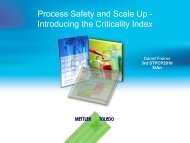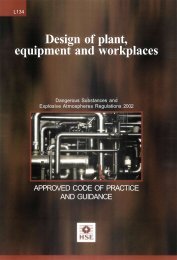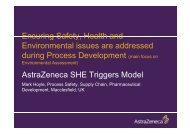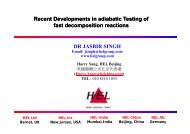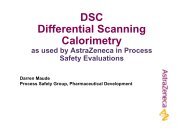Designing and operating safe chemical reaction processes HSG143
Designing and operating safe chemical reaction processes HSG143
Designing and operating safe chemical reaction processes HSG143
Create successful ePaper yourself
Turn your PDF publications into a flip-book with our unique Google optimized e-Paper software.
Health <strong>and</strong> SafetyExecutiveSelecting <strong>and</strong> specifyinga basis of <strong>safe</strong>ty126 Take the opportunity at this stage to review the process chemistry <strong>and</strong> plantrequired. Try to use some of the principles discussed earlier to design an inherently<strong>safe</strong>r process. You need to try <strong>and</strong> reduce the number, complexity <strong>and</strong> cost of‘add-on’ <strong>safe</strong>ty features <strong>and</strong> increase the integrity of any features you do use. Askyourself the following questions:(a) Is it possible to eliminate hazardous raw materials, process intermediates orby-products by using alternative chemistry?(b) Is it possible to substitute less hazardous raw materials?(c) Have all in-process inventories of hazardous materials in storage tanks beenminimised?(d) Has all processing equipment h<strong>and</strong>ling hazardous materials been designed tominimise inventory?(e) Is process equipment located to minimise the length of hazardous materialpiping?(f) Is it possible to generate hazardous reactants in situ from less hazardous rawmaterials, rather than to have to store them on site?(g) For equipment containing materials that become unstable at elevatedtemperatures or freeze at low temperatures, is it possible to use heating <strong>and</strong>cooling fluids that limit the maximum <strong>and</strong> minimum temperatures attainable?(h) Can <strong>reaction</strong> conditions be made less severe by using a catalyst?(i)(j)Can the equipment be designed to totally contain the maximum pressuregenerated?Can equipment be designed so that it is difficult or impossible to create apotentially hazardous situation due to <strong>operating</strong> error?(k) Can process units be located to reduce or eliminate adverse impacts fromother adjacent hazardous installations?(l)Can semi-batch <strong>processes</strong> be modified to reduce accumulation of reactants?(m) Has the heating effect of the surroundings been considered under failureconditions when working below ambient temperatures or using reactorheating?This list is not exhaustive, but it should give you a flavour of the thinking you canadopt in trying to produce an inherently <strong>safe</strong>r process.127 In many situations it will be necessary to provide additional <strong>safe</strong>ty measures.These can be of two types:(a) preventive, ie they reduce the likelihood of a hazardous situation occurring; <strong>and</strong><strong>Designing</strong> <strong>and</strong> <strong>operating</strong> <strong>safe</strong> <strong>chemical</strong> <strong>reaction</strong> <strong>processes</strong> Page 26 of 64





